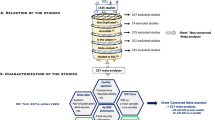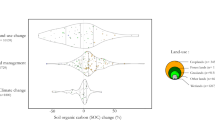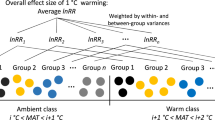Abstract
Soil carbon is currently being monitored in European national greenhouse-gas (GHG) inventories. Reviewing the data and methods, we find that unreported losses could be around 70 MtCO2 yr–1 in croplands, and unreported gains could be around 15 MtCO2 yr–1 in grasslands and 45 MtCO2 yr–1 in forests. The share of European Union (EU) forest area for which soil carbon is being accurately reported is at most 33%, and more likely close to 24%. Accuracy is even worse for grasslands and croplands. Widespread adoption of key carbon-farming practices (peatland restoration, agroforestry, substituting maize with grass) could remove an additional 150–350 MtCO2 yr–1. Yet, if effective policies lead to realizing this potential, current GHG inventories would not capture their climate mitigation benefits.
This is a preview of subscription content, access via your institution
Access options
Access Nature and 54 other Nature Portfolio journals
Get Nature+, our best-value online-access subscription
$29.99 / 30 days
cancel any time
Subscribe to this journal
Receive 12 print issues and online access
$209.00 per year
only $17.42 per issue
Buy this article
- Purchase on Springer Link
- Instant access to full article PDF
Prices may be subject to local taxes which are calculated during checkout



Similar content being viewed by others
Data availability
The raw data underlying all tables and figures in the manuscript are provided in the Supplementary Information as spreadsheets.
References
Allen, M. et al. Technical Summary. In Special Report on Global Warming of 1.5 °C (eds Masson-Delmotte, V. et al.) (WMO, 2018).
In-Depth Analysis in Support of the Commission Communication COM(2018) 773—A Clean Planet for All—A European Long-Term Strategic Vision for a Prosperous, Modern, Competitive and Climate Neutral Economy (European Commission, 2018).
Pellerin, S. et al. Stocker du carbone dans les sols français, quel potentiel au regard de l’objectif 4 pour 1000 et à quel coût? (INRAE, 2019); https://hal.archives-ouvertes.fr/hal-02284521. Quantifies the carbon storage potential of eight major practices at the national scale in France for different carbon prices.
Augère-Granier, M.-L. Agroforestry in the European Union (European Parliament, 2020).
Lugato, E., Bampa, F., Panagos, P., Montanarella, L. & Jones, A. Potential carbon sequestration of European arable soils estimated by modelling a comprehensive set of management practices. Glob. Change Biol. 20, 3557–3567 (2014). Quantifies the carbon storage potential of six major practices at the European scale.
Barthelmes, A. Reporting Greenhouse Gas Emissions from Organic Soils in the European Union: Challenges and Opportunities (Greifswald Mire Centre, 2018). Identifies and quantifies the inaccuracies of European national GHG inventories regarding organic soils.
Peatlands in the EU—Common Agriculture Policy (CAP) after 2020 (Greifswald Mire Centre, 2020).
Haddaway, N. R. et al. How does tillage intensity affect soil organic carbon? A systematic review. Environ. Evid. 6, 30 (2017).
Ogle, S. M. et al. Scale and uncertainty in modeled soil organic carbon stock changes for US croplands using a process-based model. Glob. Change Biol. 16, 810–822 (2010).
Achat, D. L., Fortin, M., Landmann, G., Ringeval, B. & Augusto, L. Forest soil carbon is threatened by intensive biomass harvesting. Sci. Rep. 5, 15991 (2015).
Mayer, M. et al. Influence of forest management activities on soil organic carbon stocks: a knowledge synthesis. For. Ecol. Manage. 466, 118127 (2020).
Mary, B., Clivot, H., Blaszczyk, N., Labreuche, J. & Ferchaud, F. Soil carbon storage and mineralization rates are affected by carbon inputs rather than physical disturbance: evidence from a 47-year tillage experiment. Agric. Ecosyst. Environ. 299, 106972 (2020).
Leifeld, J. et al. Organic farming gives no climate change benefit through soil carbon sequestration. Proc. Natl Acad. Sci. USA 110, E984–E984 (2013).
Barthelmes, A., Couwenberg, J., Risager, M., Tegetmeyer, C. & Joosten, H. Peatlands and Climate in a Ramsar Context (Norden, 2015).
Solberg, S. et al. Analyses of the impact of changes in atmospheric deposition and climate on forest growth in European monitoring plots: A stand growth approach. For. Ecol. Manage. 258, 1735–1750 (2009).
Zaehle, S. et al. Carbon and nitrogen cycle dynamics in the O-CN land surface model: 2. role of the nitrogen cycle in the historical terrestrial carbon balance. Glob. Biogeochem. Cycles 24, GB1006 (2010).
Clivot, H. et al. Modeling soil organic carbon evolution in long-term arable experiments with AMG model. Environ. Model. Softw. 118, 99–113 (2019).
Bellamy, P. H. et al. Carbon losses from all soils across England and Wales 1978–2003. Nature 437, 245–248 (2005).
Martin, M. P. et al. Feasibility of the 4 per 1000 aspirational target for soil carbon: a case study for France. Glob. Change Biol. 27, 2458–2477 (2021).
Fernández-Ugalde, O., Ballabio, C., Lugato, E., Scarpa, S. & Jones, A. Assessment of Changes in Topsoil Properties in LUCAS Samples Between 2009/2012 and 2015 Surveys (European Commission, 2020); https://doi.org/10.2760/5503
Smith, P. et al. How to measure, report and verify soil carbon change to realize the potential of soil carbon sequestration for atmospheric greenhouse gas removal. Glob. Change Biol. 26, 219–241 (2020). Review of the scientific and technical challenges of soil monitoring.
Voltz, M. et al. La cartographie des sols en France: Etat des lieux et perspectives (INRA, 2018); http://www.gissol.fr/wp-content/uploads/2018/10/Rapport-complet-Carto-Sols-France-juillet2018.pdf
Makipaa, R., Hakkinen, M., Muukkonen, P. & Peltoniemi, M. The costs of monitoring changes in forest soil carbon stocks. Boreal Environ. Res. 13, 120–130 (2008).
Cevallos, G., Grimault, J. & Bellassen, V. Domestic Carbon Standards in Europe—Overview and Perspectives (I4CE, 2019).
Calvo Buendia, E. et al. (eds) in 2019 Refinement to the 2006 IPCC Guidelines for National Greenhouse Gas Inventories Vol. 4 (IPCC, WMO, UNEP, 2019).
Report on the Individual Review of the Annual Submission of Norway Submitted in 2020 (UNFCCC, 2021).
Report of the Conference of the Parties on Its Nineteenth Session, Held in Warsaw from 11 to 23 November 2013 (UNFCCC, 2014).
Hansen, M. C. et al. High-resolution global maps of 21st-century forest cover change. Science 342, 850–853 (2013).
Lugato, E. et al. Soil erosion is unlikely to drive a future carbon sink in Europe. Sci. Adv. 4, eaau3523 (2018).
Smith, J. et al. Projected changes in mineral soil carbon of European croplands and grasslands, 1990–2080. Glob. Change Biol. 11, 2141–2152 (2005).
Yigini, Y. & Panagos, P. Assessment of soil organic carbon stocks under future climate and land cover changes in Europe. Sci. Total Environ. 557–558, 838–850 (2016).
Wiesmeier, M. et al. Projected loss of soil organic carbon in temperate agricultural soils in the 21st century: effects of climate change and carbon input trends. Sci. Rep. 6, 32525 (2016).
Griscom, B. W. et al. Natural climate solutions. Proc. Natl Acad. Sci. USA 114, 11645–11650 (2017).
Doelman, J. C. et al. Afforestation for climate change mitigation: potentials, risks and trade‐offs. Glob. Change Biol. 26, 1576–1591 (2020).
Emmett, B. A. et al. Soils Report from 2007 (Centre for Ecology & Hydrology, 2010).
Grüneberg, E., Ziche, D. & Wellbrock, N. Organic carbon stocks and sequestration rates of forest soils in Germany. Glob. Change Biol. 20, 2644–2662 (2014).
Ciais, P. et al. The European carbon balance. Part 2: croplands. Glob. Change Biol. 16, 1409–1428 (2010).
IPCC 2013 Supplement to the 2006 IPCC Guidelines for National Greenhouse Gas Inventories: Wetlands (eds Hiraishi, T. et al.) (IPCC, 2014).
Acknowledgements
An early draft of this manuscript was submitted to the European Commission as an advisory note in view of the preparation of the impact assessment of future EU climate legislation. As such, it benefited from EU funding under grant no. 208659 and from the useful comments of V. Forlin (European Commission, DG Clima), F. Claeys (European Commission, DG Clima), V. Blujdea (European Commission, JRC) and R. A. Vinas (European Commission, JRC). The finalization of this work benefited from funding from the EJP Soil Road4Schemes project (European Commission, grant agreement no. 862695). Our understanding of which practices were captured by national greenhouse-gas inventories was kindly checked by the inventory compilers themselves: P. Weiss (Austria), A. Guns (Belgium), L. Stoeva (Bulgaria), E. Cienciala (Czech Republic), S. Gyldenkærne (Denmark), C. Robert (France), K. Black and B. Hyde (Ireland), M. Vitello (Italy), A. Said (Malta), P. Canaveira (Portugal), G. Nicodim (Romania), T. Priwitzer (Slovakia), B. Mali (Slovenia) and I. Martinez Castro (Spain). We also thank A. Barthelmes for her insights on wetlands. D.A. is affiliated with Université Laval as Adjunct Professor and Agriculture and Agri-Food Canada (AAFC) as Honorary Scientist. Views and opinions expressed in this paper are those of the authors only.
Author information
Authors and Affiliations
Contributions
V.B. designed the study and wrote the first draft. V.B. and T.K. collected and analysed the data from greenhouse gas inventories. D.A. coordinated the compilation of average soil carbon changes (Table 3). D.A. and A.O. reviewed and revised the manuscript.
Corresponding author
Ethics declarations
Competing interests
The authors declare no competing interests.
Peer review
Peer review information
Nature Climate Change thanks Liesl Wiese-Rozanov, Yusuf Yigini and the other, anonymous, reviewer(s) for their contribution to the peer review of this work.
Additional information
Publisher’s note Springer Nature remains neutral with regard to jurisdictional claims in published maps and institutional affiliations.
Supplementary information
Supplementary Information
Supplementary figures, tables, discussion and references.
Supplementary Data 1
Emissions and removals for EU land areas.
Supplementary Data 2
Reporting methods in EU GHG inventories and compilation of storage potential estimates at EU level.
Supplementary Data 3
Compilation of soil carbon change estimates at large scales from soil inventories.
Rights and permissions
About this article
Cite this article
Bellassen, V., Angers, D., Kowalczewski, T. et al. Soil carbon is the blind spot of European national GHG inventories. Nat. Clim. Chang. 12, 324–331 (2022). https://doi.org/10.1038/s41558-022-01321-9
Received:
Accepted:
Published:
Issue Date:
DOI: https://doi.org/10.1038/s41558-022-01321-9
This article is cited by
-
Forest carbon stock development following extreme drought-induced dieback of coniferous stands in Central Europe: a CBM-CFS3 model application
Carbon Balance and Management (2024)
-
The legacy of one hundred years of climate change for organic carbon stocks in global agricultural topsoils
Scientific Reports (2023)
-
Flower strips as a carbon sequestration measure in temperate croplands
Plant and Soil (2023)
-
Mapping and monitoring peatland conditions from global to field scale
Biogeochemistry (2023)



